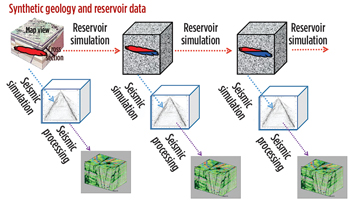What's new in exploration
SEG stimulates debates on data, technology and mammal monitoring
|
Last month, I stated that “rocks and thorns” should be avoided—I should have said “reefs and spears.” Within the first hour at this year’s SEG annual meeting in Denver, I heard about 16 seismic ships that were either at port or coming to port. That is significant, and more are likely to put into port. Hearing that PGS is giving up its first Ramform vessel was the equivalent of hearing that Santa Claus fired Rudolph. Almost as depressing was the number of geos, who told me that they elected to attend the URTeC conference instead of SEG.
What’s “new.” The interest at SEG’s meeting focused on these technologies—seismic processing migration with 19 sessions, reservoir characterization with nine, plus full waveform inversion [eight], interpretation [eight], rock physics [seven], and seismic acquisition and design [seven]. Geophysicists love to argue with equations about processing, since there is sameness to images between approaches. I find it interesting that we are still discussing multiples. Workstation folks are deluded into thinking that there are no multiples, while processors are seeking ways to use multiples to find primaries. Nigel Anstey used to say, 40 years ago, that if it were not for multiples, there would be no seismic data. The work by Arthur Weglein at the University of Houston, Mission-Oriented Seismic Research Program (M-OSRP) (http://mosrp.uh.edu/) is more than noteworthy. His work on the earth experiment, using RTM, is a point to remember. Reservoir characterization comes in as a strong second, if you do not count the number of times shale oil was mentioned. It is about time that geologists, petrophysicists, geophysicists, reservoir engineers and completions engineers get together and discuss what they do, and the honest limitations of their data sets. How all those tie together is critical for a successful well and a long production life. Speaking of which, SEG-SEAM is starting a new project called “Life of Field Subsurface Simulation” (see chart on this page). Here is a quote: “SEAM Life of Field data will be generated for complex geology, complete reservoir description, and seismic. Reservoir dynamics will then be simulated, along with the resulting well and geophysical and geomechanical responses. The resulting data can be used to estimate the ‘inverse’ problem of interpreting reservoir dynamics in a unique condition, where everything about the reservoir is known. The project will initiate on or before Jan. 1, 2015, and be scaled to complete deliverables within a two-year period.” A second “new” was a packed SEG session on the Marine Mammals Protection Act and its effect on seismic production. While there were still many snickers and sarcasms toward the environmental concerns that are often quoted on web pages, the truth is, folks, the Enviros have already won. The courts have ruled that data do not exist to show harm or lack of harm. It does not matter that BSEE continues to make a claim of what we want to hear. What does matter is when explorationists deliver actual data, on both seismic and mammal monitoring, that the court will rule is “true” enough to bring progress to this problem. We can deliver the ultimate in data, but it will not alleviate restraints at all, until the court of public opinion allows the industry to proceed in a more expeditious manner. None of us actually knows what the “hard” safe zone limits are for a particular mammal, but we do need to find them and tell the world. What’s new in technology? If an idea can be put on a computer, it was at SEG this year. I saw not just awesome interpretation products—some need a “wunderkind” to run them—but seamless use of multiple databases to define an entire play. For example, the DrillingInfo-Transform interpretation software does a very credible job of using land data, wells, seismic, horizons, tops, logs and 3D viz easily on an ordinary laptop. Most interpreters today are savvy in computer use; geo-gamers at level 3. However, most were born after DOS came into use, and neither can they use Unix. Fewer, yet, can code program. MS 8 operations software has over 20 million lines of code. Ok, more than that. I would guess half of that is dumbed out. Programmers I have talked with are scared to remove it, since it could be tied to some flow that they need for their add-in. Great software today would be the ones with the fewest legacy issues. Upstarts actually have an advantage. Newer, smaller, wireless acquisition products were announced, but not at the individual geophone level, yet. Microfiber technology, FOSS, to measure micro-seismic events, went to center stage, as well as anything to do with frac monitoring. Expanded abstracts are available from the SEG website. |

- The reserves replacement dilemma: Can intelligent digital technologies fill the supply gap? (March 2024)
- Prices and governmental policies combine to stymie Canadian upstream growth (February 2024)
- U.S. producing gas wells increase despite low prices (February 2024)
- U.S. drilling: More of the same expected (February 2024)
- U.S. oil and natural gas production hits record highs (February 2024)
- What's new in exploration (January 2024)




